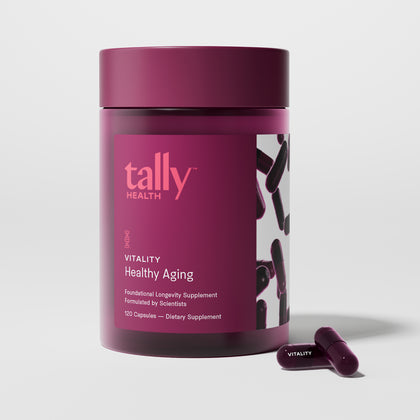

There’s something magical about watching fireworks on the Fourth of July as we “ohh” and “ahh” over the burst of colors. Luckily, we don’t have to wait all year to experience this moment of awe. Consider the spectacular solar eclipse in April or the rare sight of the Northern Lights visible in the US due to solar storms. These are classic examples of vast things—phenomena in nature that are so immense and extraordinary they inspire awe. These events remind us of our world’s incredible beauty and power, sparking curiosity and a deeper connection with the world and the people around us. Now, science suggests that experiencing awe may also help us live longer (another excellent reason to enjoy the fireworks this year).
What is awe, and where can it be found?

Awe is a complex emotion that researchers have defined as a “sense of wonder we feel in the presence of something vast that transcends our understanding of the world” [1]. It’s often marked by a slightly open mouth, exclamations like “wow,” or the sensation of goosebumps [2]. This emotion evokes feelings of wonder, astonishment, and sometimes even fear [3]. Remarkably, the sense of awe is 75% universal, though it may vary across cultures and individuals [4].
An awe experience is characterized by encountering something of great vastness or significance that transcends ordinary understanding, often leading to a sense of connection, diminished self-focus, and expanded perspective.
While nature is the most common awe trigger, it is not the only source [5]. Awe can also arise from acts of kindness or bravery, music, art, spiritual practices, collective rituals, religious ceremonies, and significant life events like birth and death [2].
The health and longevity benefits of awe

What happens when we watch fireworks, a sunset, or witness the Grand Canyon? During these awe-inspiring moments, our brains release oxytocin, the “love hormone.” Oxytocin levels particularly increase during acts of courageousness or kindness that cultivate awe [2]. This hormone enhances social interactions by fostering trust and building relationships and can reduce blood pressure, cortisol, and pain [6,7]. One benefit of awe is that it can make people feel good, contributing to overall well-being.
We all understand the detrimental effects of stress on our health. Stress can accelerate epigenetic aging and significantly reduce life expectancy [8,9]. In fact, we’ve found that perceived stress is significantly associated with an older epigenetic age [10]. Studies from institutions such as the UCSF Memory and Aging Center show that individuals who experience more awe in their daily lives report lower levels of daily stress [11]. These findings, as detailed in a recent scientific article, underscore the benefit of awe on life satisfaction and its potential to mitigate daily stressors.
Awe is also associated with increased parasympathetic nervous system activation, promoting calm and enhancing vagal tone, further reducing stress and inflammation [12, 2]. Moreover, research indicates that awe can improve mood and elevate many positive emotions, such as gratitude, joy, and contentment [13]. Experiencing awe can also affect the body, leading to changes in posture and self-perception.
And if it often feels like time is just flying by, awe can alter this perception, making you feel as if more time is available and reducing impatience [14]. Participants who experienced awe were also more inclined to volunteer and prioritize experiences over material goods. After awe experiences, participants might draw themselves smaller in relation to vast backgrounds, reflecting how awe can make us feel small and humble.
Furthermore, awe plays a crucial role in social dynamics. It significantly correlates with pro-social behaviors like altruism and increases generosity [15]. Researchers suggest that experiencing awe may help us realize our smallness in the grand scheme of things, diminishing our egos and shifting our focus to the greater good. Awe can promote self transcendence, helping individuals move beyond self-interest and fostering compassion. As a result, awe-inspired experiences can enhance social connectedness and are associated with a 50% increased likelihood of long-term survival [16].
The dark side of awe

Experiencing a sunset or witnessing a NASA space launch can elicit those spine-tingling moments of positive awe. However, life also presents instances of negative or fear-based awe. Fascinatingly, a study examined the neural differences between individuals who experienced positive versus negative awe. Positive awe, which evokes wonder and amazement, contrasts with negative awe (e.g., watching tornadoes or volcanic eruptions), which is linked to decreased self-control, heightened fear, and uncertainty [17].
The study revealed that individuals experiencing positive awe had a greater gray matter volume in the insula, a brain region connecting emotions with cognitive and behavioral experiences, including self-reflection. Conversely, those experiencing negative awe had less gray matter in this area. Interestingly, another study found that regardless of whether participants experienced positive or negative awe, both groups displayed pro-social behaviors [18].
Overcoming barriers to awe

In our fast-paced world, it’s easy to feel disconnected from the sense of wonder that awe brings. Many of us rush through daily life, focused on to-do lists and screens, rarely pausing to notice the beauty or vastness around us. Yet, experiencing awe—even in small doses—can be a simple practice with profound benefits for mental health, life satisfaction, and overall wellbeing.
One common barrier to awe is the relentless speed of modern living, which can leave us feeling overwhelmed and distracted. To counter this, try incorporating an awe walk into your routine. An awe walk is more than just a stroll; it’s an intentional, mindful moment to slow down, breathe in fresh air, and focus on your surroundings with curiosity. Whether you’re walking through green spaces, city streets, or even your own neighborhood, pay attention to the details—the way sunlight filters through leaves, the sound of birds, or the architecture that surrounds you. This mindful approach can help you experience awe in everyday life, boosting positive emotions and reducing stress levels.
Access to nature or green spaces is another challenge, especially for those living in urban environments. But awe isn’t limited to grand landscapes like the Grand Canyon. You can feel awe while listening to a piece of music that moves you, reading a book that sparks new ideas, or witnessing a small act of kindness. By seeking awe in the ordinary—like the colors of a sunset, the laughter of a child, or the intricate design of a flower—you can cultivate a sense of wonder and connection, no matter where you are.
It’s also a common misconception that awe requires extraordinary or life-changing events. In reality, awe experiences can be found in the simplest moments. For example, pausing to appreciate the beauty of a single flower, the vastness of the night sky, or the creativity in a piece of art can all inspire feelings of awe. By being open, curious, and willing to focus on the present, you can invite more awe into your daily life.
Clinical psychology research shows that experiencing awe can reduce stress, increase happiness, and improve mental wellbeing. In one eight-week study, participants who took regular awe walks reported more positive emotions, greater compassion, and a stronger sense of connection to the world around them. This simple practice can help you feel more alive, inspired, and connected, even amidst the busyness of daily routines.
Overcoming barriers to awe is about making a conscious choice to seek out and appreciate the beauty, vastness, and wonder in your surroundings. By prioritizing awe—whether through awe walks, enjoying music, spending time in green spaces, or simply noticing the small moments that make you feel awestruck—you can experience the many benefits of awe, from reduced stress to increased creativity and kindness.
As one wellness co-founder puts it, “Awe is a powerful emotion that can help us feel more connected to the world and to ourselves. By incorporating awe into our daily lives, we can experience a range of benefits, from reduced stress to increased creativity and compassion.” So, take a moment today to step outside, look up, and let yourself be inspired by the world’s wonders—big or small. You might be surprised by how these moments of awe can transform your mood, spark new ideas, and help you emerge from your routine feeling more alive and connected.
Tips for cultivating more awe

Experiencing the breathtaking view from the summit of Mount Kilimanjaro or watching the Northern Lights dance across the sky are indeed awe-inspiring moments. However, we also recognize that daily awe can be experienced in the simplest places. Try to associate awe with everyday moments and routines, such as mindful walks, appreciating sensory experiences, or journaling about what moves you. Here are some ways to invite more awe into your life:
Take an "awe" walk:
The concept of "mental health walks" has gained popularity on social media, and for good reason. Research indicates that when older adults took a 15-minute daily "awe walk"—where they mindfully observed their surroundings with a renewed sense of wonder—they experienced increased hopefulness and positivity [19]. Thus, taking a short daily walk benefits your health and mood through physical exercise and enhances your overall well-being by cultivating a sense of awe.
Spend time in nature:
Numerous studies have shown that nature is a powerful source of awe [20]. Prioritizing outdoor activities, such as hiking a new trail with friends on the weekend, enjoying a yoga session at sunrise, or simply stepping outside to watch the sunset, is a simple way to enjoy nature while embracing more awe.
Immerse yourself in art and culture:
Art is a powerful source of awe. Whether the opening number of a Broadway show gives you goosebumps or you feel a sense of camaraderie cheering alongside a crowd at a baseball game, making time for art, music, sports, or other live performances can evoke a profound sense of wonder and awe [21].
Engage with inspirational content:
Witnessing acts of courage or kindness can evoke a profound sense of awe and strengthen our connection to humanity. For instance, watching a documentary about athletes who triumphed against overwhelming odds to win championships or reading stories of individuals who have made significant positive impacts on their communities, such as "Humans of New York," can inspire us to appreciate and contribute to the goodness in the world [22].
Volunteer to help others:
Experiencing awe often inspires us to lend a hand, so why not make volunteering your awe-inspiring activity [23]? Acts of kindness and bravery evoke awe and help us connect with a larger purpose and contribute to the greater good.
Write about awe:
Recall a recent moment when you felt a deep sense of awe and describe it in detail. Research indicates that documenting these awe-inspiring experiences helps us relive those sensations and strengthen our connection to awe [22].
Engage in shared experiences:
Awe fosters a sense of social connectedness, so participating in group activities with like-minded individuals can amplify this feeling, whether joining a CrossFit gym, attending a Taylor Swift concert, or volunteering for a cause that matters to you [24].
Take control of how you age

Tally Health is your partner in longevity, offering easy-to-follow, scientifically grounded tips to help foster a lifestyle that makes living healthier, longer more achievable for everyone. Tally Health members also receive unique lifestyle tips based on their unique DNA methylation profile designed to help them lower their epigenetic age.
What is awe and where can it come from?
Awe is a complex emotion described as a “sense of wonder in the presence of something vast that transcends our understanding of the world.” While nature is the most common source, awe can also be sparked by music, art, acts of kindness, spiritual practices, or life events like birth and death.
How does awe benefit health and longevity?
Experiencing awe can reduce stress, lower blood pressure and cortisol, enhance mood, boost immune response, and foster social connection. It’s associated with better vagal tone, reduced inflammation, and even a 50% increased likelihood of long-term survival.
How can you experience more awe in daily life?
You can cultivate awe by taking mindful “awe walks,” spending time in nature, enjoying art or music, volunteering, writing about awe-inspiring experiences, and engaging in shared activities with others that spark wonder or connection.
Recommended Supplements
Citations
[1] Paul K. Piff, Pia Dietze, Matthew Feinberg, Daniel M. Stancato, Dacher Keltner. Awe, the small self, and prosocial behavior.. Journal of Personality and Social Psychology, 2015; 108 (6): 883 DOI: 10.1037/pspi000001
[2] Monroy, M., & Keltner, D. (2023). Awe as a Pathway to Mental and Physical Health. Perspectives on Psychological Science, 18(2), 309-320. https://doi.org/10.1177/17456916221094856
[3] Guan, F., Zhao, S., Chen, S., Lu, S., Chen, J., & Xiang, Y. (2019). The Neural Correlate Difference Between Positive and Negative Awe. Frontiers in Human Neuroscience, 13, 461622. https://doi.org/10.3389/fnhum.2019.00206
[4] Cowen, A.S., Keltner, D., Schroff, F. et al. Sixteen facial expressions occur in similar contexts worldwide. Nature 589, 251–257 (2021). https://doi.org/10.1038/s41586-020-3037-7
[5] Greater Good Science Center at UC Berkeley. (2018). The science of awe. Greater Good Science Center at UC Berkeley. Retrieved from https://ggsc.berkeley.edu/images/uploads/GGSC-JTF_White_Paper-Awe_FINAL.pdf
[6] Uvnas-Moberg, K., & Petersson, M. (2005). Oxytocin, ein Vermittler von Antistress, Wohlbefinden, sozialer Interaktion, Wachstum und Heilung [Oxytocin, a mediator of anti-stress, well-being, social interaction, growth and healing]. Zeitschrift fur Psychosomatische Medizin und Psychotherapie, 51(1), 57–80. https://doi.org/10.13109/zptm.2005.51.1.57
[7] Jones, C., Barrera, I., Brothers, S., Ring, R., & Wahlestedt, C. (2017). Oxytocin and social functioning. Dialogues in Clinical Neuroscience, 19(2), 193-201. https://doi.org/10.31887/DCNS.2017.19.2/cjones
[8] Harvanek, Z.M., Fogelman, N., Xu, K. et al. Psychological and biological resilience modulates the effects of stress on epigenetic aging. Transl Psychiatry 11, 601 (2021). https://doi.org/10.1038/s41398-021-01735-7
[9] Tommi Härkänen, Kari Kuulasmaa, Laura Sares-Jäske, Pekka Jousilahti, Markku Peltonen, Katja Borodulin, Paul Knekt, Seppo Koskinen. Estimating expected life-years and risk factor associations with mortality in Finland: cohort study. BMJ Open, 2020; 10 (3): e033741 DOI: 10.1136/bmjopen-2019-033741
[10] Shokhirev MN, Torosin NS, Kramer DJ, Johnson AA, Cuellar TL. CheekAge: a next-generation buccal epigenetic aging clock associated with lifestyle and health. Geroscience. 2024 Jun;46(3):3429-3443. doi: 10.1007/s11357-024-01094-3. Epub 2024 Mar 5. PMID: 38441802; PMCID: PMC11009193.
[11] Bai, Y., Ocampo, J., Jin, G., Chen, S., Benet-Martinez, V., Monroy, M., Anderson, C., & Keltner, D. (2021). Awe, daily stress, and elevated life satisfaction. Journal of personality and social psychology, 120(4), 837–860. https://doi.org/10.1037/pspa0000267
[12] Takano, R., & Nomura, M. (2023). A closer look at the time course of bodily responses to awe experiences. Scientific Reports, 13(1), 1-10. https://doi.org/10.1038/s41598-023-49681-2
[13] Alexander J. Smalley, Mathew P. White. Beyond blue-sky thinking: Diurnal patterns and ephemeral meteorological phenomena impact appraisals of beauty, awe, and value in urban and natural landscapes. Journal of Environmental Psychology, 2023; 101955 DOI: 10.1016/j.jenvp.2023.101955
[14] Rudd, M., Vohs, K. D., & Aaker, J. (2012). Awe expands people's perception of time, alters decision making, and enhances well-being. Psychological science, 23(10), 1130–1136. https://doi.org/10.1177/0956797612438731
[15] Paul K. Piff, Pia Dietze, Matthew Feinberg, Daniel M. Stancato, Dacher Keltner. Awe, the small self, and prosocial behavior.. Journal of Personality and Social Psychology, 2015; 108 (6): 883 DOI: 10.1037/pspi0000018
[16] Holt-Lunstad J, Smith TB, Layton JB (2010) Social Relationships and Mortality Risk: A Meta-analytic Review. PLoS Med 7(7): e1000316. https://doi.org/10.1371/journal.pmed.1000316
[17] Guan, F., Zhao, S., Chen, S., Lu, S., Chen, J., & Xiang, Y. (2019). The Neural Correlate Difference Between Positive and Negative Awe. Frontiers in Human Neuroscience, 13, 461622. https://doi.org/10.3389/fnhum.2019.00206
[18] Paul K. Piff, Pia Dietze, Matthew Feinberg, Daniel M. Stancato, Dacher Keltner. Awe, the small self, and prosocial behavior.. Journal of Personality and Social Psychology, 2015; 108 (6): 883 DOI: 10.1037/pspi0000018
[19] Sturm, V. E., Datta, S., Roy, A. R. K., Sible, I. J., Kosik, E. L., Veziris, C. R., Chow, T. E., Morris, N. A., Neuhaus, J., Kramer, J. H., Miller, B. L., Holley, S. R., & Keltner, D. (2022). Big smile, small self: Awe walks promote prosocial positive emotions in older adults. Emotion, 22(5), 1044–1058. https://doi.org/10.1037/emo0000876
[20] Shiota, M. N., & Keltner, D. (2007). The nature of awe: Elicitors, appraisals, and effects on self-concept. Cognition and Emotion, 21(5), 944-963. Psychology Press. https://greatergood.berkeley.edu/dacherkeltner/docs/shiota.2007.pdf
[21] Kou, X., Konrath, S., & Goldstein, T. R. (2020). The relationship among different types of arts engagement, empathy, and prosocial behavior. Psychology of Aesthetics, Creativity, and the Arts, 14(4), 481–492. https://doi.org/10.1037/aca0000269
[22] Rudd, M., Vohs, K. D., & Aaker, J. (2012). Awe expands people's perception of time, alters decision making, and enhances well-being. Psychological science, 23(10), 1130–1136. https://doi.org/10.1177/0956797612438731
[23] Piff, P. K., Dietze, P., Feinberg, M., Stancato, D. M., & Keltner, D. (2015). Awe, the small self, and prosocial behavior. Journal of personality and social psychology, 108(6), 883–899. https://doi.org/10.1037/pspi0000018
[24] Graziosi, M., & Yaden, D. (2019). Interpersonal awe: Exploring the social domain of awe elicitors. The Journal of Positive Psychology, 16(2), 263–271. https://doi.org/10.1080/17439760.2019.1689422











